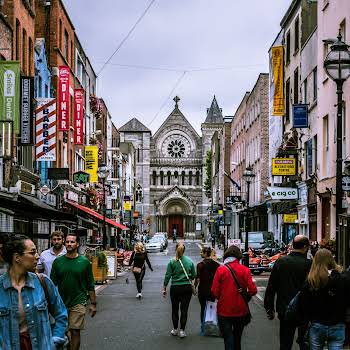
By IMAGE
17th Apr 2018
17th Apr 2018
Three years ago, CHRISTINE MANGAN returned to the US after completing her PhD in English at UCD. But on her last night in Dublin, she experienced an exchange that would leave her with a fond lasting memory she will cherish as a symbol of life in Ireland.
It was a cold, wintry day in January 2015 when I submitted my postgraduate thesis, the anticlimactic conclusion to four years of living abroad in Dublin. And though I was not yet ready to leave my adopted city behind, the completion of my studies also meant the expiration of my visa, and thus the inevitable shift from resident to visitor. With no jobs on the horizon, and my days in Dublin now literally numbered, my partner and I began the sobering task of boxing up our apartment and preparing to head back to the States. The date of departure arrived all too quickly and to celebrate our very last night in the city, we headed toward our favourite pub for a final pint. It was dark and rainy, as were most winter days in Dublin, and we were just getting ready to cross from Stephen’s Green over to Grafton Street, when we heard someone call out.
Turning, I noticed a figure standing just behind us, outside the park’s entrance. It was a man, asking for help crossing the road and, in spite of the darkness, I knew him immediately. Dublin is the type of city where, over time, you begin to recognise people as you pass them on the street, even if you don’t know them – the woman who lived in the caretaker’s house in Iveagh Gardens, and who would occasionally turn up at the Duke, a half pint in hand; the man who sat with his bunny and dog and could most often be found on Henry Street next to Arnotts; the frequent male patron of the Butlers on Wicklow Street, whose golden curls were impossible to overlook. They, along with many others, made up the backdrop that was Dublin, and were a part of what made the city so unique from other places I had lived, where faces remained distant and unknown.
“Dublin is a city where, over time, you recognise people as you pass them on the street – they were a part of what made the city so unique from other places I had lived, where faces remained distant and unknown.”
The man standing outside Stephen’s Green was an older gentleman: shorter than most, with a mess of grey hair, eyes that seemed to suggest a difficulty in seeing, and a cane that helped him to move around. I had noticed him the very first week I moved to Dublin, while seeing a midnight film at the IFI. A few weeks later I was startled, though not entirely surprised, to see him again while shopping at Dunnes in the Stephen’s Green Centre. Soon, sightings of him became commonplace. Once, I even watched as he stopped a famous actor – again, another familiar face that I’d often spied along Camden Street – to solicit help walking down a flight of stairs. Afterwards, he had pulled a notebook from his coat pocket, at which point the actor had smiled, took the proffered paper and accompanying pen and wrote – his autograph, I assumed – in the notebook before they parted.
Now, in need of similar assistance, the man took the arm of my partner, who, at over two metres, towered above him, and we began to make our way toward Grafton Street, together. We chatted as we went, answering the man’s questions about where we lived and for how long, about where we were headed to next. In turn, he told us about the place he called home. He noted that we looked familiar and we told him that we had seen him around town from time to time over the last few years. All too soon we were across the road and it was time to say goodbye. But as we turned to leave, the man stopped us, pulling something from his coat.
It was, I quickly realised, a notebook. Remembering the scene with the actor, now some time past, I opened it eagerly, curious to learn what the pages contained, no longer certain is was merely a book of autographs. Though only three years have passed since that night, I can no longer remember what the notebook looked like, what material it was made of, or even exactly how large it was. I do, however, remember what it contained: row upon row of different names and addresses, a record of all the people who had helped this man and had, similar to us, been asked to sign its pages.
I wrote down our names and address in Dublin, despite the fact that, by the following morning, the latter would no longer belong to us. We thanked him, wished him a good night, and left him at his requested destination, huddled in the doorframe of the Bus Stop Newsagents. The remainder of our walk to the pub was made in silence, both of us lost in the reverie of the past four years and everything we were about to leave behind.
I often think about that night, about that man and his notebook, and about how it made a certain sort of sense that we should have met him that night, our very last night as residents of the city, in a sort of serendipitous moment that Ireland often seems to inspire. I wonder, too, what has become of those bits of paper, that little piece of history that he had managed to preserve, perhaps unknowingly, of Dublin and the people who pass through her cobblestoned streets. It’s comforting to imagine that it’s still out there – a permanent record of my time in Ireland when all other traces have begun to fade.
Of course, my thesis sits in a library just outside of Dublin, an enduring record if ever there was one. But the notebook contains a different sort of testament: of that tiny top floor apartment to which I once held the skeleton key. It’s a tenuous but tangible link, one that will always connect me to that place – to the grey doorway situated between the charity shop and health store, to the creaky wooden stairwell and white washed door just beyond, to the living room and kitchen that overlooked a garden, to the curve of the hallway which led to the bedroom, and to the windows that overlooked the bustling street of Lower Camden, where I spent many a rain filled day, working at my desk. To a place that I once called home. A place that, despite the ever-increasing passage of time and place, will always continue to be home.
Christine Mangan’s debut novel, Tangerine, is available March 20th, 2018.
This article was originally published in the March 2018 issue of IMAGE.






















